Abstract
BACKGROUND: The role of bile in the genesis of oesophageal symptoms and disease is incompletely understood. A new method of ambulatory bile monitoring may help to define this role. AIMS: To establish the relationship between symptom events and acid and bile reflux episodes. PATIENTS: 59 consecutive patients presenting for further investigation of gastro-oesophageal reflux disease. METHODS: All patients underwent combined ambulatory pH and bile monitoring. For each patient, a symptom index (SI) was calculated in relation to both acid reflux and bile reflux episodes. RESULTS: Patients were divided into those without (group 1, n = 21) and those with (group 2, n = 38) acid reflux. A total of 394 symptoms were identified in 59 patients. In group 1, there were fewer symptom events per patient (mean 4.1) than group 2 (mean 8.1). Twenty three per cent of symptom events were associated with acid reflux in group 1 and 41% in group 2. Only 6% of symptom events in both groups were related to bile reflux. In group 1 both the acid and bile related SI score were low. In group 2 the bile related SI score was low, but the acid related SI score was high. CONCLUSIONS: Symptoms are much more often related to acid reflux than bile reflux. Bile reflux does not seem to be a major factor in producing oesophageal symptoms.
Full text
PDF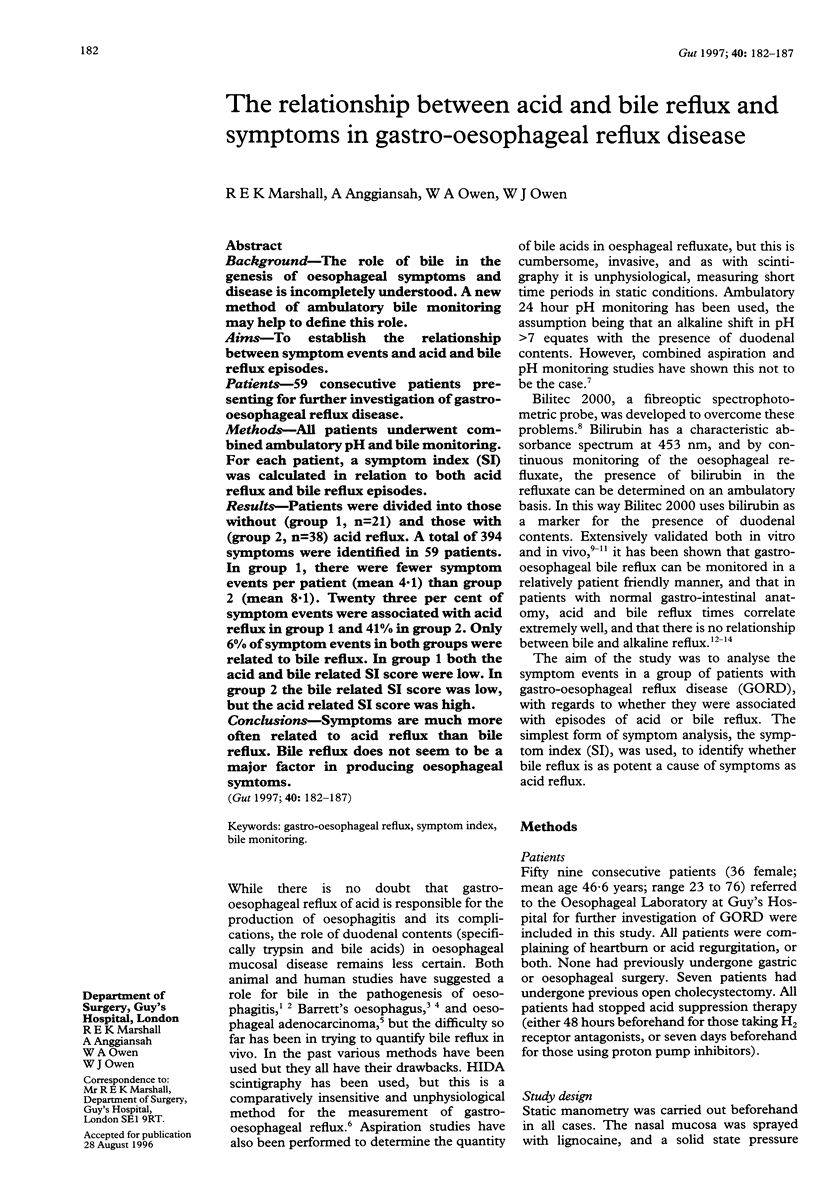

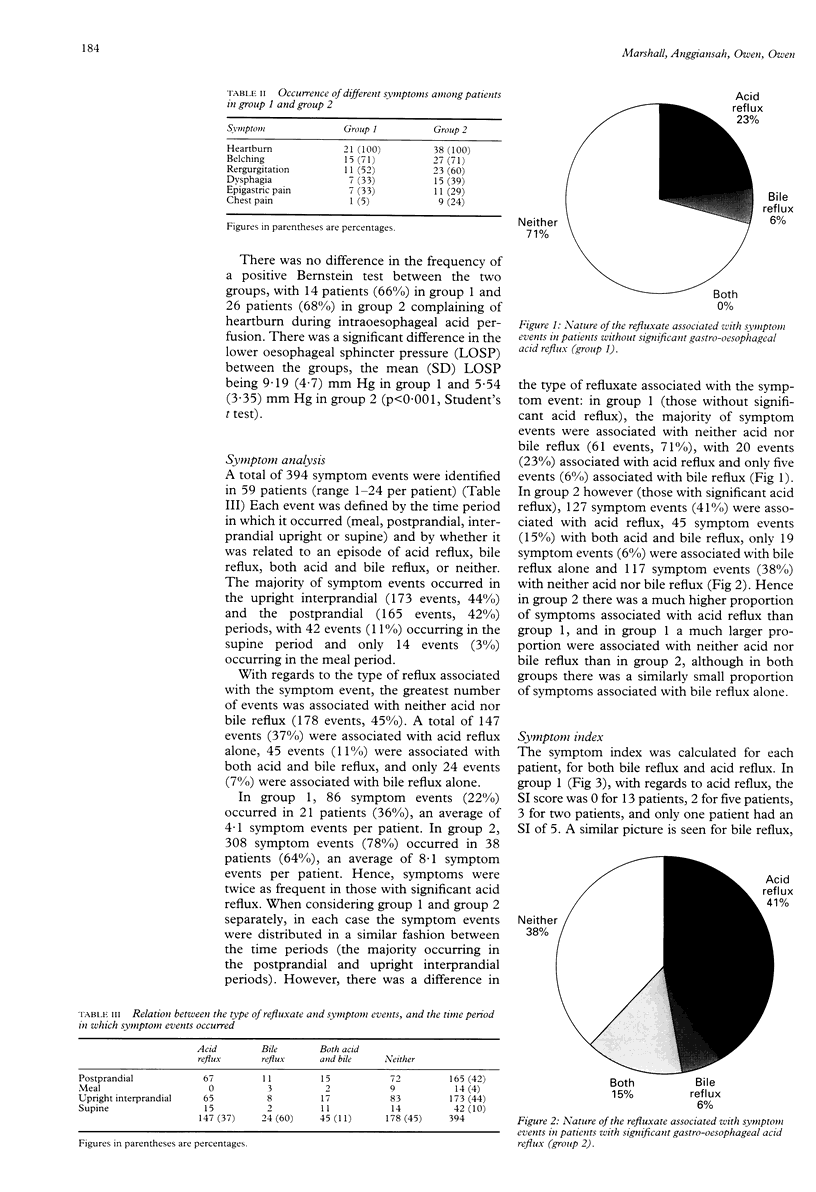
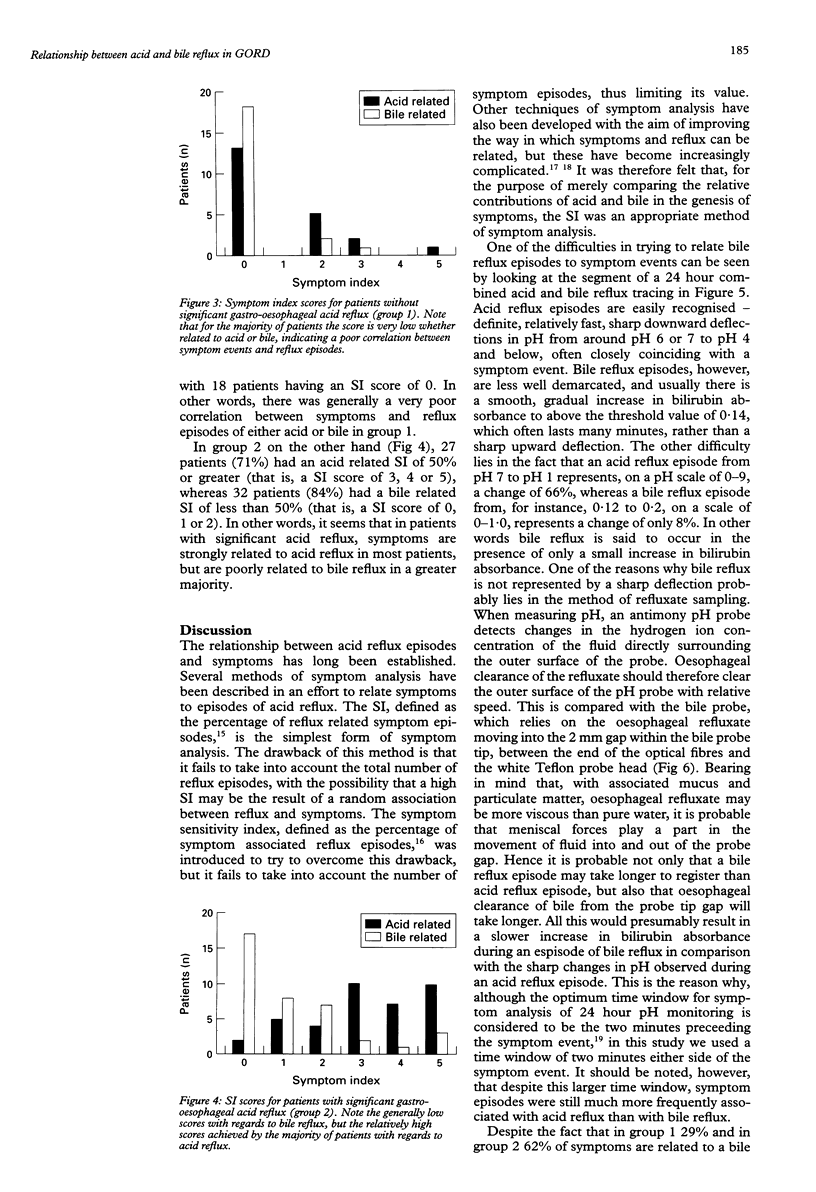
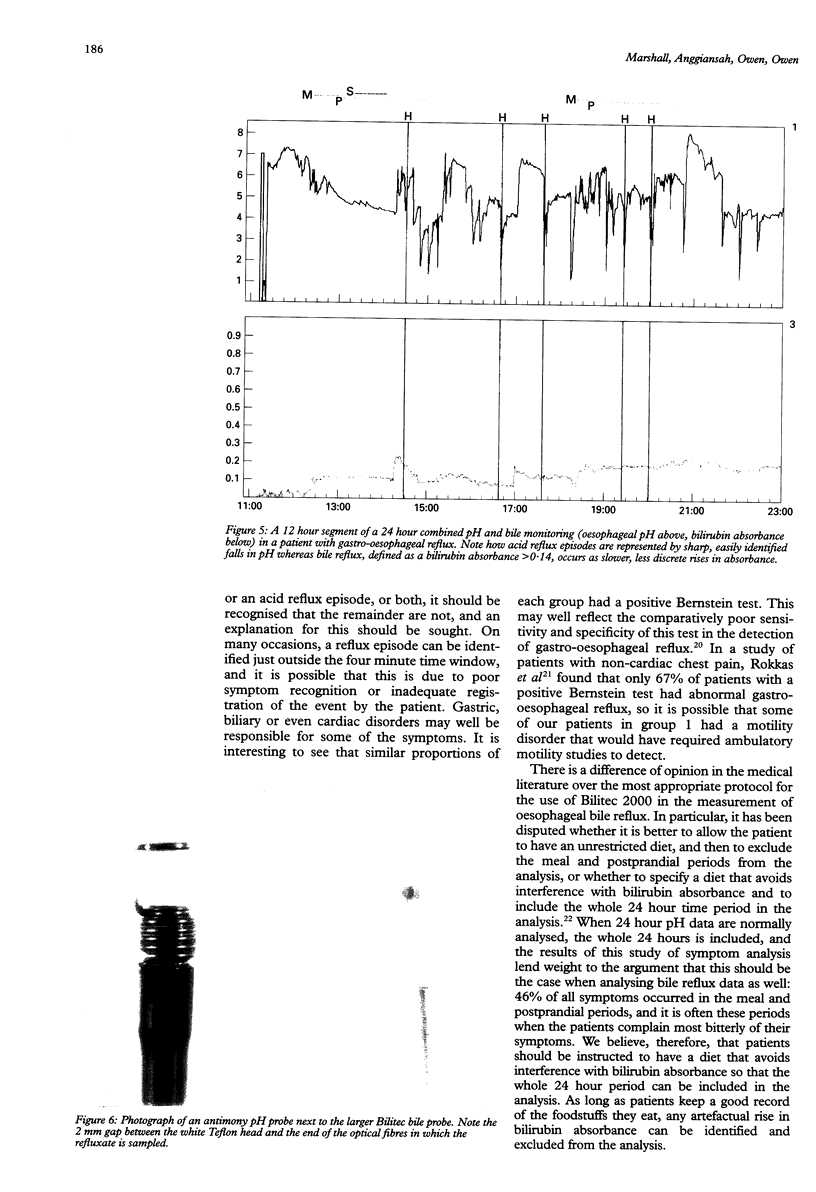
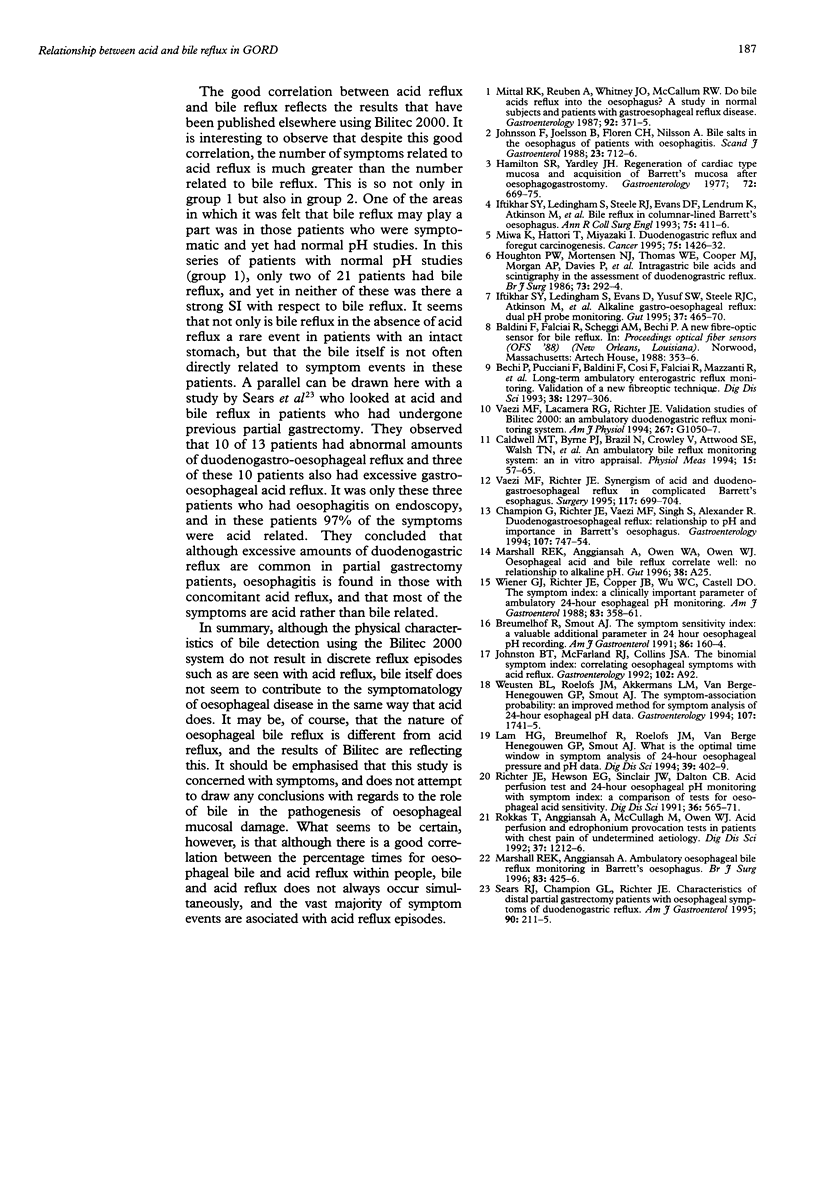
Images in this article
Selected References
These references are in PubMed. This may not be the complete list of references from this article.
- Bechi P., Pucciani F., Baldini F., Cosi F., Falciai R., Mazzanti R., Castagnoli A., Passeri A., Boscherini S. Long-term ambulatory enterogastric reflux monitoring. Validation of a new fiberoptic technique. Dig Dis Sci. 1993 Jul;38(7):1297–1306. doi: 10.1007/BF01296082. [DOI] [PubMed] [Google Scholar]
- Breumelhof R., Smout A. J. The symptom sensitivity index: a valuable additional parameter in 24-hour esophageal pH recording. Am J Gastroenterol. 1991 Feb;86(2):160–164. [PubMed] [Google Scholar]
- Caldwell M. T., Byrne P. J., Brazil N., Crowley V., Attwood S. E., Walsh T. N., Hennessy T. P. An ambulatory bile reflux monitoring system: an in vitro appraisal. Physiol Meas. 1994 Feb;15(1):57–65. doi: 10.1088/0967-3334/15/1/005. [DOI] [PubMed] [Google Scholar]
- Champion G., Richter J. E., Vaezi M. F., Singh S., Alexander R. Duodenogastroesophageal reflux: relationship to pH and importance in Barrett's esophagus. Gastroenterology. 1994 Sep;107(3):747–754. doi: 10.1016/0016-5085(94)90123-6. [DOI] [PubMed] [Google Scholar]
- Hamilton S. R., Yardley J. H. Regnerative of cardiac type mucosa and acquisition of Barrett mucosa after esophagogastrostomy. Gastroenterology. 1977 Apr;72(4 Pt 1):669–675. [PubMed] [Google Scholar]
- Houghton P. W., Mortensen N. J., Thomas W. E., Cooper M. J., Morgan A. P., Davies E. R. Intragastric bile acids and scintigraphy in the assessment of duodenogastric reflux. Br J Surg. 1986 Apr;73(4):292–294. doi: 10.1002/bjs.1800730415. [DOI] [PubMed] [Google Scholar]
- Iftikhar S. Y., Ledingham S., Evans D. F., Yusuf S. W., Steele R. J., Atkinson M., Hardcastle J. D. Alkaline gastro-oesophageal reflux: dual probe pH monitoring. Gut. 1995 Oct;37(4):465–470. doi: 10.1136/gut.37.4.465. [DOI] [PMC free article] [PubMed] [Google Scholar]
- Iftikhar S. Y., Ledingham S., Steele R. J., Evans D. F., Lendrum K., Atkinson M., Hardcastle J. D. Bile reflux in columnar-lined Barrett's oesophagus. Ann R Coll Surg Engl. 1993 Nov;75(6):411–416. [PMC free article] [PubMed] [Google Scholar]
- Johnsson F., Joelsson B., Florén C. H., Nilsson A. Bile salts in the esophagus of patients with esophagitis. Scand J Gastroenterol. 1988 Aug;23(6):712–716. doi: 10.3109/00365528809093938. [DOI] [PubMed] [Google Scholar]
- Lam H. G., Breumelhof R., Roelofs J. M., Van Berge Henegouwen G. P., Smout A. J. What is the optimal time window in symptom analysis of 24-hour esophageal pressure and pH data? Dig Dis Sci. 1994 Feb;39(2):402–409. doi: 10.1007/BF02090215. [DOI] [PubMed] [Google Scholar]
- Lam H. G., Breumelhof R., Roelofs J. M., Van Berge Henegouwen G. P., Smout A. J. What is the optimal time window in symptom analysis of 24-hour esophageal pressure and pH data? Dig Dis Sci. 1994 Feb;39(2):402–409. doi: 10.1007/BF02090215. [DOI] [PubMed] [Google Scholar]
- Marshall R. E., Anggiansah A. Ambulatory oesophageal bile reflux monitoring in Barrett's oesophagus. Br J Surg. 1996 Mar;83(3):425–426. doi: 10.1002/bjs.1800830350. [DOI] [PubMed] [Google Scholar]
- Mittal R. K., Reuben A., Whitney J. O., McCallum R. W. Do bile acids reflux into the esophagus? A study in normal subjects and patients with gastroesophageal reflux disease. Gastroenterology. 1987 Feb;92(2):371–375. doi: 10.1016/0016-5085(87)90130-2. [DOI] [PubMed] [Google Scholar]
- Miwa K., Hattori T., Miyazaki I. Duodenogastric reflux and foregut carcinogenesis. Cancer. 1995 Mar 15;75(6 Suppl):1426–1432. doi: 10.1002/1097-0142(19950315)75:6+<1426::aid-cncr2820751506>3.0.co;2-#. [DOI] [PubMed] [Google Scholar]
- Richter J. E., Hewson E. G., Sinclair J. W., Dalton C. B. Acid perfusion test and 24-hour esophageal pH monitoring with symptom index. Comparison of tests for esophageal acid sensitivity. Dig Dis Sci. 1991 May;36(5):565–571. doi: 10.1007/BF01297020. [DOI] [PubMed] [Google Scholar]
- Rokkas T., Anggiansah A., McCullagh M., Owen W. J. Acid perfusion and edrophonium provocation tests in patients with chest pain of undetermined etiology. Dig Dis Sci. 1992 Aug;37(8):1212–1216. doi: 10.1007/BF01296562. [DOI] [PubMed] [Google Scholar]
- Sears R. J., Champion G. L., Richter J. E. Characteristics of distal partial gastrectomy patients with esophageal symptoms of duodenogastric reflux. Am J Gastroenterol. 1995 Feb;90(2):211–215. [PubMed] [Google Scholar]
- Vaezi M. F., Lacamera R. G., Richter J. E. Validation studies of Bilitec 2000: an ambulatory duodenogastric reflux monitoring system. Am J Physiol. 1994 Dec;267(6 Pt 1):G1050–G1057. doi: 10.1152/ajpgi.1994.267.6.G1050. [DOI] [PubMed] [Google Scholar]
- Vaezi M. F., Richter J. E. Synergism of acid and duodenogastroesophageal reflux in complicated Barrett's esophagus. Surgery. 1995 Jun;117(6):699–704. doi: 10.1016/s0039-6060(95)80015-8. [DOI] [PubMed] [Google Scholar]
- Weusten B. L., Roelofs J. M., Akkermans L. M., Van Berge-Henegouwen G. P., Smout A. J. The symptom-association probability: an improved method for symptom analysis of 24-hour esophageal pH data. Gastroenterology. 1994 Dec;107(6):1741–1745. doi: 10.1016/0016-5085(94)90815-x. [DOI] [PubMed] [Google Scholar]
- Weusten B. L., Roelofs J. M., Akkermans L. M., Van Berge-Henegouwen G. P., Smout A. J. The symptom-association probability: an improved method for symptom analysis of 24-hour esophageal pH data. Gastroenterology. 1994 Dec;107(6):1741–1745. doi: 10.1016/0016-5085(94)90815-x. [DOI] [PubMed] [Google Scholar]
- Wiener G. J., Richter J. E., Copper J. B., Wu W. C., Castell D. O. The symptom index: a clinically important parameter of ambulatory 24-hour esophageal pH monitoring. Am J Gastroenterol. 1988 Apr;83(4):358–361. [PubMed] [Google Scholar]



